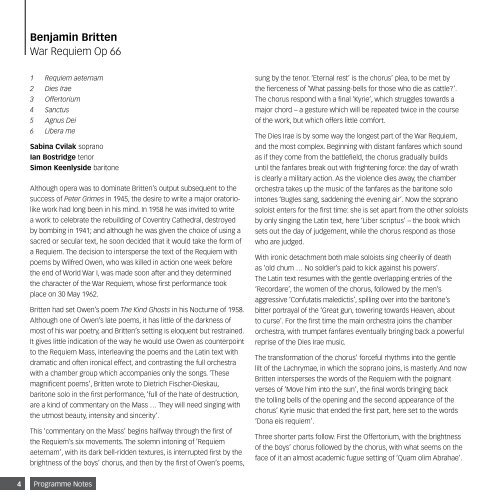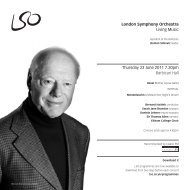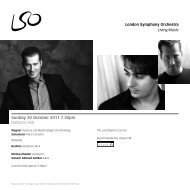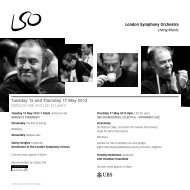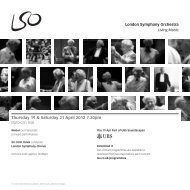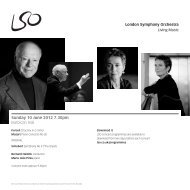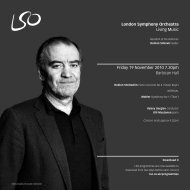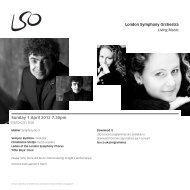9 Oct programme - London Symphony Orchestra
9 Oct programme - London Symphony Orchestra
9 Oct programme - London Symphony Orchestra
Create successful ePaper yourself
Turn your PDF publications into a flip-book with our unique Google optimized e-Paper software.
Benjamin Britten<br />
War Requiem Op 66<br />
1 Requiem aeternam<br />
2 Dies Irae<br />
3 Offertorium<br />
4 Sanctus<br />
5 Agnus Dei<br />
6 Libera me<br />
Sabina Cvilak soprano<br />
Ian Bostridge tenor<br />
Simon Keenlyside baritone<br />
Although opera was to dominate Britten’s output subsequent to the<br />
success of Peter Grimes in 1945, the desire to write a major oratoriolike<br />
work had long been in his mind. In 1958 he was invited to write<br />
a work to celebrate the rebuilding of Coventry Cathedral, destroyed<br />
by bombing in 1941; and although he was given the choice of using a<br />
sacred or secular text, he soon decided that it would take the form of<br />
a Requiem. The decision to intersperse the text of the Requiem with<br />
poems by Wilfred Owen, who was killed in action one week before<br />
the end of World War I, was made soon after and they determined<br />
the character of the War Requiem, whose first performance took<br />
place on 30 May 1962.<br />
Britten had set Owen’s poem The Kind Ghosts in his Nocturne of 1958.<br />
Although one of Owen’s late poems, it has little of the darkness of<br />
most of his war poetry, and Britten’s setting is eloquent but restrained.<br />
It gives little indication of the way he would use Owen as counterpoint<br />
to the Requiem Mass, interleaving the poems and the Latin text with<br />
dramatic and often ironical effect, and contrasting the full orchestra<br />
with a chamber group which accompanies only the songs. ‘These<br />
magnificent poems’, Britten wrote to Dietrich Fischer-Dieskau,<br />
baritone solo in the first performance, ‘full of the hate of destruction,<br />
are a kind of commentary on the Mass … They will need singing with<br />
the utmost beauty, intensity and sincerity’.<br />
This ‘commentary on the Mass’ begins halfway through the first of<br />
the Requiem’s six movements. The solemn intoning of ‘Requiem<br />
aeternam’, with its dark bell-ridden textures, is interrupted first by the<br />
brightness of the boys’ chorus, and then by the first of Owen’s poems,<br />
4 Programme Notes<br />
sung by the tenor. ‘Eternal rest’ is the chorus’ plea, to be met by<br />
the fierceness of ‘What passing-bells for those who die as cattle?’.<br />
The chorus respond with a final ‘Kyrie’, which struggles towards a<br />
major chord – a gesture which will be repeated twice in the course<br />
of the work, but which offers little comfort.<br />
The Dies Irae is by some way the longest part of the War Requiem,<br />
and the most complex. Beginning with distant fanfares which sound<br />
as if they come from the battlefield, the chorus gradually builds<br />
until the fanfares break out with frightening force: the day of wrath<br />
is clearly a military action. As the violence dies away, the chamber<br />
orchestra takes up the music of the fanfares as the baritone solo<br />
intones ‘Bugles sang, saddening the evening air’. Now the soprano<br />
soloist enters for the first time: she is set apart from the other soloists<br />
by only singing the Latin text, here ‘Liber scriptus’ – the book which<br />
sets out the day of judgement, while the chorus respond as those<br />
who are judged.<br />
With ironic detachment both male soloists sing cheerily of death<br />
as ‘old chum … No soldier’s paid to kick against his powers’.<br />
The Latin text resumes with the gentle overlapping entries of the<br />
‘Recordare’, the women of the chorus, followed by the men’s<br />
aggressive ‘Confutatis maledictis’, spilling over into the baritone’s<br />
bitter portrayal of the ‘Great gun, towering towards Heaven, about<br />
to curse’. For the first time the main orchestra joins the chamber<br />
orchestra, with trumpet fanfares eventually bringing back a powerful<br />
reprise of the Dies Irae music.<br />
The transformation of the chorus’ forceful rhythms into the gentle<br />
lilt of the Lachrymae, in which the soprano joins, is masterly. And now<br />
Britten intersperses the words of the Requiem with the poignant<br />
verses of ‘Move him into the sun’, the final words bringing back<br />
the tolling bells of the opening and the second appearance of the<br />
chorus’ Kyrie music that ended the first part, here set to the words<br />
‘Dona eis requiem’.<br />
Three shorter parts follow. First the Offertorium, with the brightness<br />
of the boys’ chorus followed by the chorus, with what seems on the<br />
face of it an almost academic fugue setting of ‘Quam olim Abrahae’.


